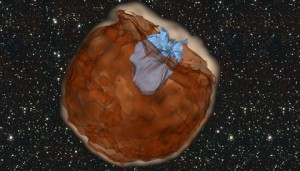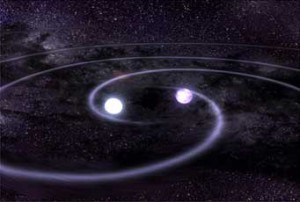Two new studies confirm that the white dwarfs that explode as Type Ia supernovae can approach death in two different ways.
Astronomers care a lot about white dwarfs. These stellar cores are left behind when stars like the Sun slough off their outer layers. They’re a couple hundred thousand times as dense as our planet, capable of shoving half a Sun’s worth of mass into an Earth-size ball. (Mass-wise, it would take about 300,000 Earths to make the Sun.)
But astronomers care most about white dwarfs when they die. When white dwarfs eat too much, they burst through a strict weight restriction called the Chandrasekhar limit and trigger a thermonuclear blast deep inside themselves. This fusion bomb generally annihilates the white dwarf in what’s called a Type Ia supernova.

Dan Kasen
Type Ia explosions are so dependable in how their light brightens and fades, and in how those changes depend on the supernova’s intrinsic brightness, that astronomers can use them to gauge the distances to the dying white dwarfs — and, therefore, to the galaxies they sit in. They can also calculate how those distances are changing: measuring how fast Type Ia host galaxies are receding from us led astronomers to the unsettling discovery that the universe is now expanding at an accelerating rate.
But although Type Ia help form the backbone of the cosmic distance ladder, astronomers don’t know the nuts and bolts of the systems that spawn these explosions. For many years, astronomers have debated just how the white dwarf maxes out its mass. There are two scenarios: either it siphons gas from a “living” companion star until it just can’t swallow any more (called the single-degenerate model), or it merges with another dead star like itself (the double-degenerate model). Which scenario is more likely depends on whom you ask and which particular supernova you’re looking at. In fact, papers and press releases proclaiming evidence of one solution or the other have become so common that I’ve frankly started ignoring them. The growing sense — and not just because of my journalistic cynicism — is that white dwarfs probably die both ways.
Two papers in the May 21st Nature support this suspicion. One reports an ultraviolet pulse from a supernova that, the authors say, is a telltale signal that the white dwarf was stealing material from a companion star. The other study finds no evidence for such a signal from three supernovae.
How to Destroy a White Dwarf
Yi Cao (Caltech) and colleagues detected the extra UV in light from the Type Ia supernova iPTF14atg. They caught the supernova’s start with the intermediate Palomar Transient Factory (iPTF) survey, then followed up with the UV and X-ray capabilities of NASA’s Swift satellite. The latter revealed an uptick in UV emission for four days after the explosion, a pulse that the authors propose arose when the exploding white dwarf’s ejecta slammed into its companion star. The signal would then have disappeared once the ejecta engulfed the companion enough to hide the shocked gas created by the collision.
Rob Olling (University of Maryland) and colleagues took a different approach: they used archival observations from the Kepler mission to study three supernovae that lit up in the space telescope’s field of view. Two of these supernovae (KSN 2011b and KSN 2012a) are clearly Type Ia; the third (KSN 2011c) is probably one. The team used the same theoretical predictions as Cao’s team did to analyze their data and found no sign of ejecta slamming into companion stars.

Kepler doesn't look in UV, and Cao’s team didn’t see iPTF14atg’s ejecta shock in visible wavelengths. But Olling says that Kepler’s sensitivity is so tremendous that, had there been a signal from material colliding with a companion star, his team would have seen it in visible light. Thus, the astronomers favor a dual white dwarf death as the origin for these three (likely) Type Ia events.
So basically, the Type Ia supernovae in these two studies have different origins.
iPTF14atg is an oddball Type Ia: it’s intrinsically dimmer than a normal Type Ia. Two other, less luminous Type Ia events also appear to come from single-degenerate systems: SN 2008ha and SN 2012Z. Cao’s team tentatively suggests that all subluminous Type Ia supernovae might come from white dwarfs with companion stars.
But stellar astronomer Ryan Foley (University of Illinois at Urbana-Champaign) cautions against jumping to that conclusion. iPTF14atg is a “weird” supernova, similar to a family of subluminous supernovae named after their founding father, SN 2002es. And the other dim supernovae, SN 2008ha and SN 2012Z, both appear to be yet another breed of Type Ia, called Type Iax, with lower peak brightnesses and ejecta velocities. These two families are both low-energy explosions, and they don’t necessary work the same way that a typical Type Ia does.
So although these dim supernovae might all have been single-degenerate systems, that doesn’t mean all subluminous Type Ia events signal the death of white dwarfs sucking material from normal companion stars. It essentially boils down to the old logical fallacy: all cows eat grass, but that doesn’t mean that all grass-eaters are cows.
Now the question is, which scenario is more common? A recent review favors the double degenerate pathway, but I’d wager that won’t be the last word in this debate. Nor, of course, will this blog.
References:
Yi Cao et al. "A strong ultraviolet pulse from a newborn type Ia supernova." Nature. May 21, 2015.
Rob P. Olling et al. "No signature of ejecta interaction with a stellar companion in three type Ia supernovae." Nature. May 21, 2015.
Dan Maoz, Filippo Mannucci,and Gijs Nelemans. "Observational Clues to the Progenitors of Type Ia Supernovae." Annual Review of Astronomy and Astrophysics. Vol. 52: 107-170 (August 2014).
 5
5









Comments
Justin S
May 20, 2015 at 6:06 pm
It would seem to me that white dwarfs “siphoning” off mass from a companion star would all explode at about the same mass, meaning they would all be about the same brightness. But in the case of two merging white dwarfs, they could have widely varying total masses. An explosion resulting from such a merger should vary considerably in brightness depending on the total mass of the pair.
You must be logged in to post a comment.
May 21, 2015 at 11:17 am
Justin, Type Ia supernovae don't all have the same brightness, and that is okay. There is an observed relationship between the light curve shape and colors and the peak brightness, so that a distance can be inferred from the peak luminosity. These observed relationships account for most of the differences in type Ia supernovae so that they are still good distance indicators. There are some odd subclasses which don't follow these relationships and more detailed studies are understanding smaller differences between normal objects. So if a difference in the mass results in a difference in the luminosity, it seems to be accounted for in the observed relationships.
You must be logged in to post a comment.
Chandler-Kennedy
May 22, 2015 at 6:59 pm
A recent paper [The Astrophysical Journal, 803:20 (15pp), 2015 April 10] titled THE CHANGING FRACTIONS OF TYPE IA SUPERNOVA NUV–OPTICAL SUBCLASSES WITH REDSHIFT indicates two classes of Type Ia supernovae based on NUV spectrum. Their relative abundance varies with redshift and their absolute brightnesses differ. This discovery has an important impact on the claim that cosmic expansion is accelerating. Are the two classes identified in this paper related to single vs double degenerate supernovae?
You must be logged in to post a comment.
May 23, 2015 at 9:20 pm
Thanks, Camille!
So question then. If these variations in Type 1a Supernova Luminosities are now observed, what are the implications for our understanding of the Universe's expansion if that was our standard of measurement?
You must be logged in to post a comment.
Camille M. CarlislePost Author
May 27, 2015 at 12:37 pm
Hi Circadia,
Actually, the comment by reader uvsupernova answers your question well: based on how the explosion's light brightens and fades, and how that's related to the explosion's intrinsic brightness, we can figure out the intrinsic luminosity and, therefore, the distance. So we can still use the different types of Type Ia as standard candles. Also, Type Ia SNe aren't the only way we measure the universe's expansion -- another way is with baryonic acoustic oscillations. See my colleague's blog at http://skyandtelescope.org/astronomy-news/boss-a-ruler-to-measure-them-all-0108201423/ for more info.
You must be logged in to post a comment.
You must be logged in to post a comment.